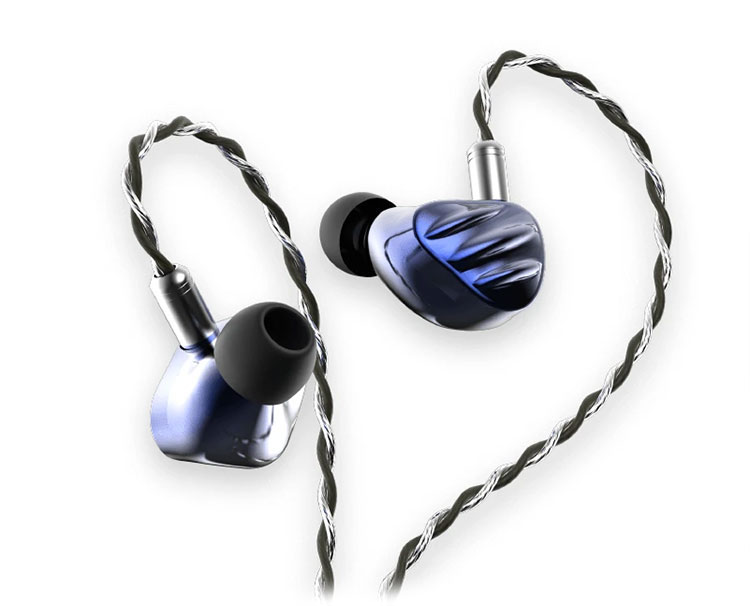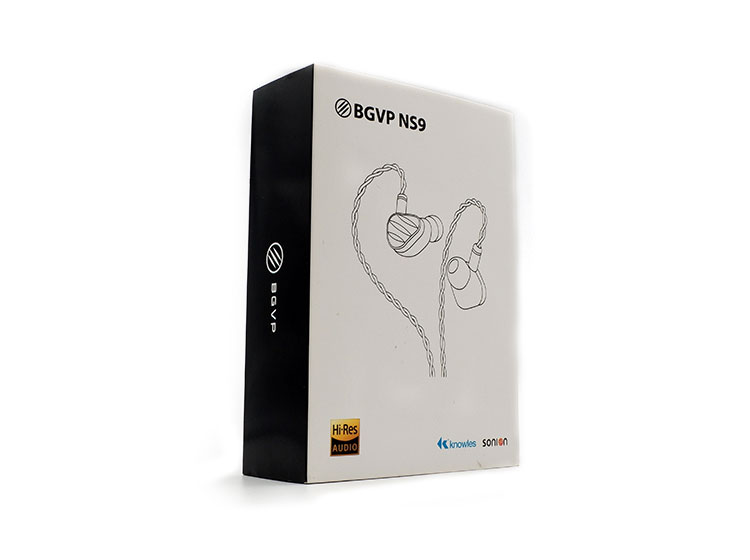Tuning Options
Synergy
Filters
When the NS9 arrives, it has the black filters attached to the IEMs out of the box. These produce a middle ground in tonality among the 3 choices of filters, so I would say that this is the stock tonality of the NS9.
The red filter would further push down the treble response of the NS9, creating a perception of a warmer tonality. The silver filters on the other hand slightly elevate the treble for a more even-handed tonal balance.
Filters won’t make a night and day difference in terms of tonality, and it’s very subtle even when it’s compared to how much ear tips change the tonality. It’s a nice feature to have though since it allows options for fine-tuning the overall tonality.
Ear Tips
The ear tips have a more significant effect on the NS9’s tuning. The stock ear tips on the NS9 are large bore silicone ear tips. Aside from the stock ear tips, BGVP also sends over 3 other types of ear tips. They are labeled inside the box, and with my listening tests, the labels are pretty accurate.
The white ear tips are labeled as bass ear tips, and true enough they elevate the bass response and make the bass response a bit more rounded. However, this results in slightly less control over the bass region, and a slightly more scattered imaging presentation.
The firm stem ear tips are labeled as vocal ear tips inside the box. And it lives up to that label. It also results in a slightly more rolled-off and subdued bass response. The nice thing about these ear tips it that it allows the NS9 to retain control over most of the frequency range.
The foam tips typically elevate bass, fortunately, this isn’t exactly the case with the NS9. The foam tips make the NS9 sound more tightly controlled, and surprisingly the bass is a touch pulled back.
While the foam tips make the NS9 sound much tighter, the soundstage also becomes much more intimate, and the images seem to be much closer than they are with the other tips.
Efficiency
At an impedance of 20Ω, and a sensitivity of 107dB/mW, the NS9 can easily be powered by anything that can output audio. Using a 2.5mm balanced to 3.5mm single-ended adaptor, I was able to plug the NS9 into my Xiaomi Redmi Note 9 Pro, and my phone easily powered the NS9 to the highest listenable volumes with my phone at just 80% of maximum volume.
Sonically though, my phone couldn’t bring out the full potential of the NS9. Plugging in the NS9 into my Audioquest Dragonfly Red, the NS9 ‘s treble sparkle was appropriately elevated, and there is a marked improvement over the control over the bass region.
Moving on to my iBasso DX200 showed that the NS9 improved with higher quality sources, as the DX200 gave the NS9 a tighter grip over the bass and a more crystalline treble sparkle.
Select Comparisons
NiceHCK NX7 MK3
Technical
When I was reading through the specs sheet of the NS9, and I opened the box, I immediately remembered the NX7 Mk3. It’s because they have so much in common. They both have interchangeable nozzles, which gives both IEMs a wider degree of tuning flexibility.
The driver composition is also strikingly similar between the 2 IEMs. They both have 2 dynamic drivers producing the bass frequencies, and 4 BA drivers producing midrange. However, with the 7 drivers on the NX7, the last driver is a piezoelectric driver that produces the treble frequencies, while the NS9 utilizes even more BA drivers for the upper midrange and the treble frequencies.
One thing that sets the NS9 apart from the NX7 though is that it has a 4-way crossover, which gives the manufacturer more control over the tuning of the combination of drivers. This would allow it to potentially have a more coherent tonal balance if done right.
On the specs sheet, it says that both IEMs have a sensitivity of around 107dB/mW, but the NS9 has a significantly lower impedance at 20Ω. This translates to the NX7 needing around 12 volume steps of difference on the DX200 for volume matching.
So the NX7 ends up being a bit more difficult to drive with a smartphone, but most dedicated music players shouldn’t have a problem with either IEM.
Design
The choices available upon order are also very similar, where you are given the choice of either a 3.5mm single-ended termination, or a 2.5mm or a 4.4mm balanced termination. Both IEMs arrived with us with a 2.5mm balanced termination.
While the 2 IEMs have a lot of similarities internally, the NS9 has a CNC milled aluminum shell, while the NX7 has a plastic shell with interchangeable faceplates. This makes the NS9 seem to be more durable and smoother around the edges.
Performance
With a similar driver configuration, I would have expected that they would both have a similarly forward bass region. However, I was surprised that the 2 IEMs have a different overall tonal presentation.
The NX7 ends up being a touch more neutral, with less of a mid-bass hump despite also having 2 dynamic drivers producing the bass. While the NX7 has a more pulled-back bass region, it’s still generally more hollowed, and a bit more glossed over.
With a more even tonal presentation, the midrange on the NX7 is presented as a bit more forward. Vocal and instrument timbre is a bit drier though but ends up a bit fuller because of a more planted fundamental. The NX7’s instrument presentation is more full-bodied while having a slightly warmer instrument timbre.
While both IEMs stay away from being too bright, the NX7 does so by having a more glossed-over presentation, while the NS9 has a more controlled and cleaner presentation.
When it comes to the overall width of the soundstage, the NX7 is a bit wider, however, the layering within the soundstage is comparable between the 2. Both IEMs have equal competence when it comes to directionality, and forming a center image. Where the center image is well within my head, and there are dead spots between the directional extremes.
When it comes to presenting gentler passages, both IEMs present dainty piano passages with much finesse. However, when it comes to grand emotional crescendos, the NX7 falls short of the emotional engagement that can be brought about by the NS9.
Mangird MT4
Design
Upon arrival, the NS9 is sent over in a much fancier package when compared to the stripped-down packaging of the MT4. The MT4 is limited to just a carrying case, a small box, and a clear case stuffed with ear tips.
Although in reality, the MT4 comes with pretty much the same number of ear tips as the NS9. It’s just that the MT4 doesn’t have an option for interchanging the nozzle filters.
With the cables, the MT4 also comes with a simpler cable, where the cable arrives with a 3.5mm single-ended termination. Although the MT4’s cable can easily be upgraded with an aftermarket cable since it’s terminated with a 0.78mm 2-pin connection.
The shells on the MT4 look strikingly different from the NS9 though. The MT4 has 3D printed resin shells that look similar to custom IEMs, while the NS9 has CNC milled aluminum shells. In use, both shells are ergonomically designed, so prolonged use will not be a problem.
With the MT4, it has a fixed steel nozzle with a lip, so it doesn’t have any of the tuning options available to the NS9. However, the lip on the MT4 still allows for ear tip flexibility, since it would ensure that most ear tips won’t fall off of the MT4.
Technical
The MT4 only has 4 drivers, and it’s composed of a dynamic driver for the bass, 2 BA drivers for the midrange, and a BA driver for the treble. So essentially, the MT4 has a 3-way crossover, while the NS9 has a 4-way crossover circuit. This would mean that the NS9 has more tuning paraments when it was designed.
On the specs sheet, the MT4 has an impedance of 22Ω, and an SPL of 112dB/mW. With an impedance that is 2Ω higher and an SPL that’s 5dB louder, this means that the MT4 plays a touch louder at the same volume settings of a DAP.
Performance
Compared to the NS9, the MT4 has a more even-handed presentation, if anything, it has a more mid-centric presentation. The bass is a bit more subdued, but the immediacy of the attack with the MT4 is still as fast, if not faster. The definition of the bass frequencies is also a bit more controlled, and the sub-bass is not as environmental.
The vocal range is a bit drier on the MT4, while still having a measured amount of midrange presence. The upper midrange is also a bit more filled out, giving midrange instruments a touch more warmth. However, don’t expect a euphonic character in the MT4, as it tends to be dry, rather than flowy.
The treble is quite similar, where cymbal hits are equally immediate. The harmonic balance is also as clear, so brighter instruments can come through very clearly on both IEMs. While the treble is equally clear, the MT4 can be counterclockwise tilted when compared to the more bass-centric NS9.
Soundstage is equally wide and expansive, and images tend to play as wide on both IEMs. However, the MT4 edges out the NS9 on imaging, where the MT4 can create a more coherent center image that is pushed forward to the tip of my nose.
This creates a more natural feeling soundstage overall. While image directionality is about equal, the layering and separation between images are a touch more fleshed out on the MT4. Orchestral tracks and piano recordings convey a better sense of emotion since the MT4 has a wider perceived dynamic range.
Our Verdict
The NS9 is an IEM with lots of tuning options, including interchangeable nozzles, and options for ear tips out of the box. While some of them may have some disadvantages, it allows the NS9 to appeal to a wider audience with different tastes.
With the different tuning options available, I thoroughly enjoyed the different options available on the NS9. The most notable tuning option in my opinion is a warmer and more euphonic V-shaped tuning with the silver filter.
This tuning is not what I expect to hear from “reference” IEMs, but it’s really a welcome break from the monotony of aiming for a dry and neutral reference sound signature.
BGVP NS9 Specifications
- Powerful nine-driver hybrid configuration.
- Three pairs of tuning filters.
- Composite Titanium-plated silicone diaphragm material.
- 3D-printed acoustic structure.
- Four-way electronic crossover.
- CNC machined ear cavities made using Aviation-grade aluminum alloy.
- High-quality silver-plated braided cable
- Impedance:20 ohms.
- Sensitivity: 107dB/mW.
- Frequency Response: 10Hz-40kHz.
- Channel Difference: <1dB(20-10kHz).
- Distortion: <0.5%(1kHz)




